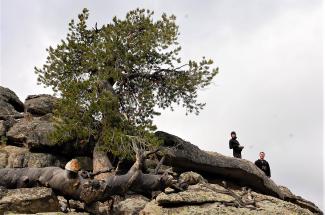Dr. Diana Tomback (Professor, CU Denver Dept. of Integrative Biology) just published, a landmark issue of the peer-reviewed journal (Elsevier) Forest Ecology and Management on “The ecology and restoration of high elevation five-needle white pines.” She was lead editor with colleagues Robert Keane and Richard Sniezko, experts with the US Forest Service. An introductory overview, plus commentary from the editors, and a list of papers, can be found here. The link to the issue can be shared for free downloads for 6 months. Below is some of the introductory overview:
 The six high elevation five-needle white pines—whitebark (Pinus albicaulis), limber (Pinus flexilis), southwestern white (P. strobiformis), foxtail (P. balfouriana), Rocky Mountain bristlecone (P. aristata), and Great Basin bristlecone (P. longaeva)—(Family Pinaceae, Genus Pinus, Subgenus Strobus) are ecologically important to western montane coniferous forests. These pines, restricted to subalpine and treeline communities and often on windswept, rocky slopes, are of limited timber value and thus were historically of lower management interest. In the last 30 years, we have come to recognize the ecological roles of the “high five” pines with respect to the diverse forest types they support and ecosystem services provided. Five of these pines are threatened by white pine blister rust and also experienced high losses during the recent mountain pine beetle (Dendroctonus ponderosae) outbreaks. These pines are also threatened by altered fire regimes, drought, and other effects from a changing climate. Whitebark pine, listed as Endangered in Canada under the Species at Risk Act (SARA), is currently being evaluated under the Endangered Species Act in the U.S.; and limber pine is being evaluated for listing under SARA. Papers in this special issue will discuss current developments in ecology, management tools that have been devised and implemented on small scales for many of these pines, and conservation/restoration plans. With emerging technologies, some restoration tools are currently undergoing refinement. For example, we hope that technologies based on genomics may expedite identification of blister rust-resistance within populations. Regional conservation strategies have been or are being developed for whitebark and limber pine, and the National Whitebark Pine Restoration Plan was inaugurated in 2017. This is a U.S. range-wide strategy led by two NGO's in consultation with the USDA Forest Service, other federal agencies, and tribal jurisdictions
The six high elevation five-needle white pines—whitebark (Pinus albicaulis), limber (Pinus flexilis), southwestern white (P. strobiformis), foxtail (P. balfouriana), Rocky Mountain bristlecone (P. aristata), and Great Basin bristlecone (P. longaeva)—(Family Pinaceae, Genus Pinus, Subgenus Strobus) are ecologically important to western montane coniferous forests. These pines, restricted to subalpine and treeline communities and often on windswept, rocky slopes, are of limited timber value and thus were historically of lower management interest. In the last 30 years, we have come to recognize the ecological roles of the “high five” pines with respect to the diverse forest types they support and ecosystem services provided. Five of these pines are threatened by white pine blister rust and also experienced high losses during the recent mountain pine beetle (Dendroctonus ponderosae) outbreaks. These pines are also threatened by altered fire regimes, drought, and other effects from a changing climate. Whitebark pine, listed as Endangered in Canada under the Species at Risk Act (SARA), is currently being evaluated under the Endangered Species Act in the U.S.; and limber pine is being evaluated for listing under SARA. Papers in this special issue will discuss current developments in ecology, management tools that have been devised and implemented on small scales for many of these pines, and conservation/restoration plans. With emerging technologies, some restoration tools are currently undergoing refinement. For example, we hope that technologies based on genomics may expedite identification of blister rust-resistance within populations. Regional conservation strategies have been or are being developed for whitebark and limber pine, and the National Whitebark Pine Restoration Plan was inaugurated in 2017. This is a U.S. range-wide strategy led by two NGO's in consultation with the USDA Forest Service, other federal agencies, and tribal jurisdictions
Whitebark pine, the fastest declining of the white pines discussed, has been proposed by US Fish & Wildlife Services for listing as a threatened species; the listing decision is due at any time this fall. One of the papers published in this issue (Tomback and Sprague 2022) presents an ambitious restoration plan for whitebark pine, led by the Whitebark Pine Ecosystem Foundation and American Forests and developed in consultation with the U.S. Forest Service, National Park Service, Bureau of Land Management, U.S. Fish & Wildlife Service, and several Native American tribal jurisdictions. Dr. Tomback has been involved in plan development since its inception.
Photo Credit: D.F. Tomback
